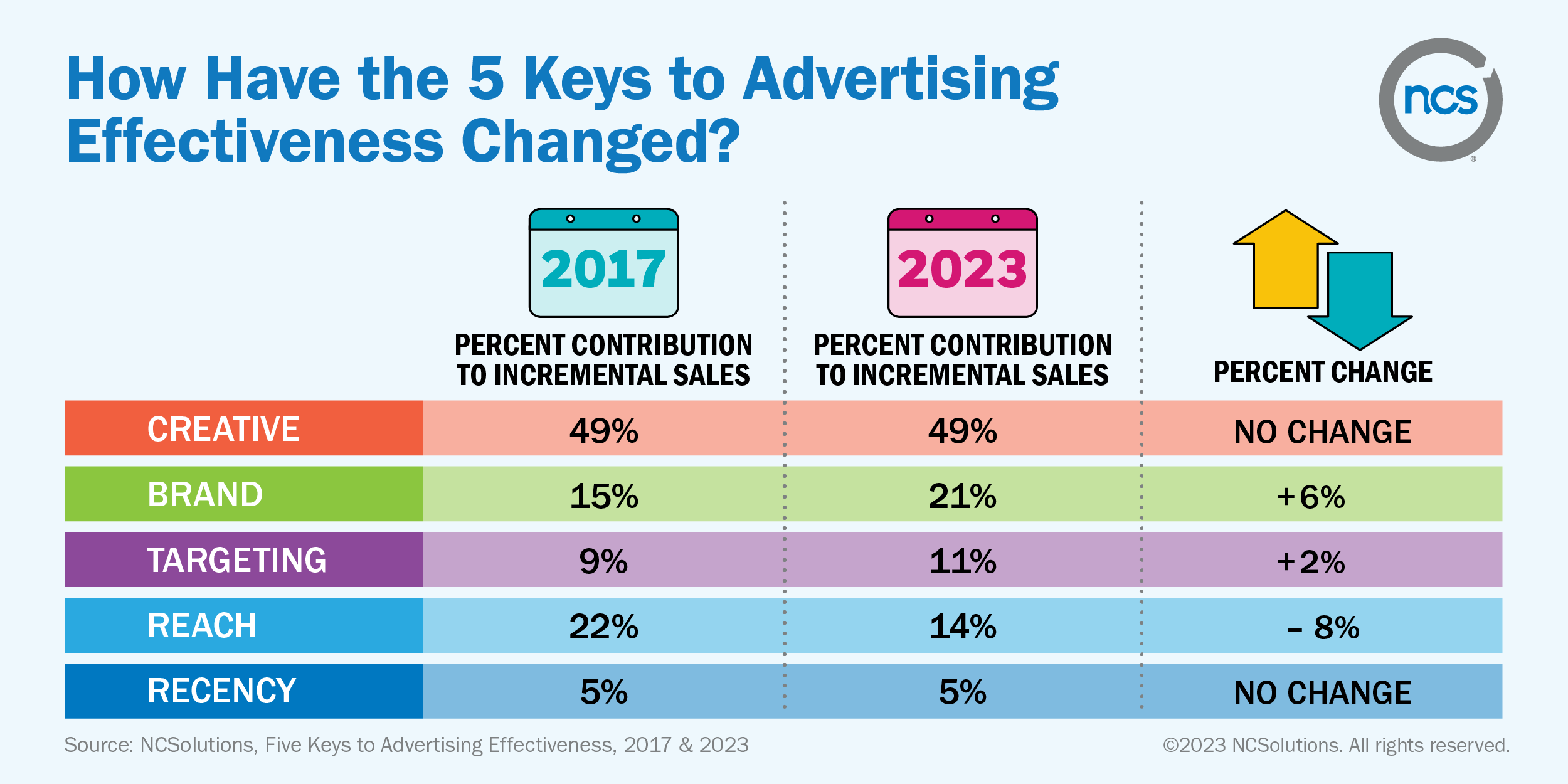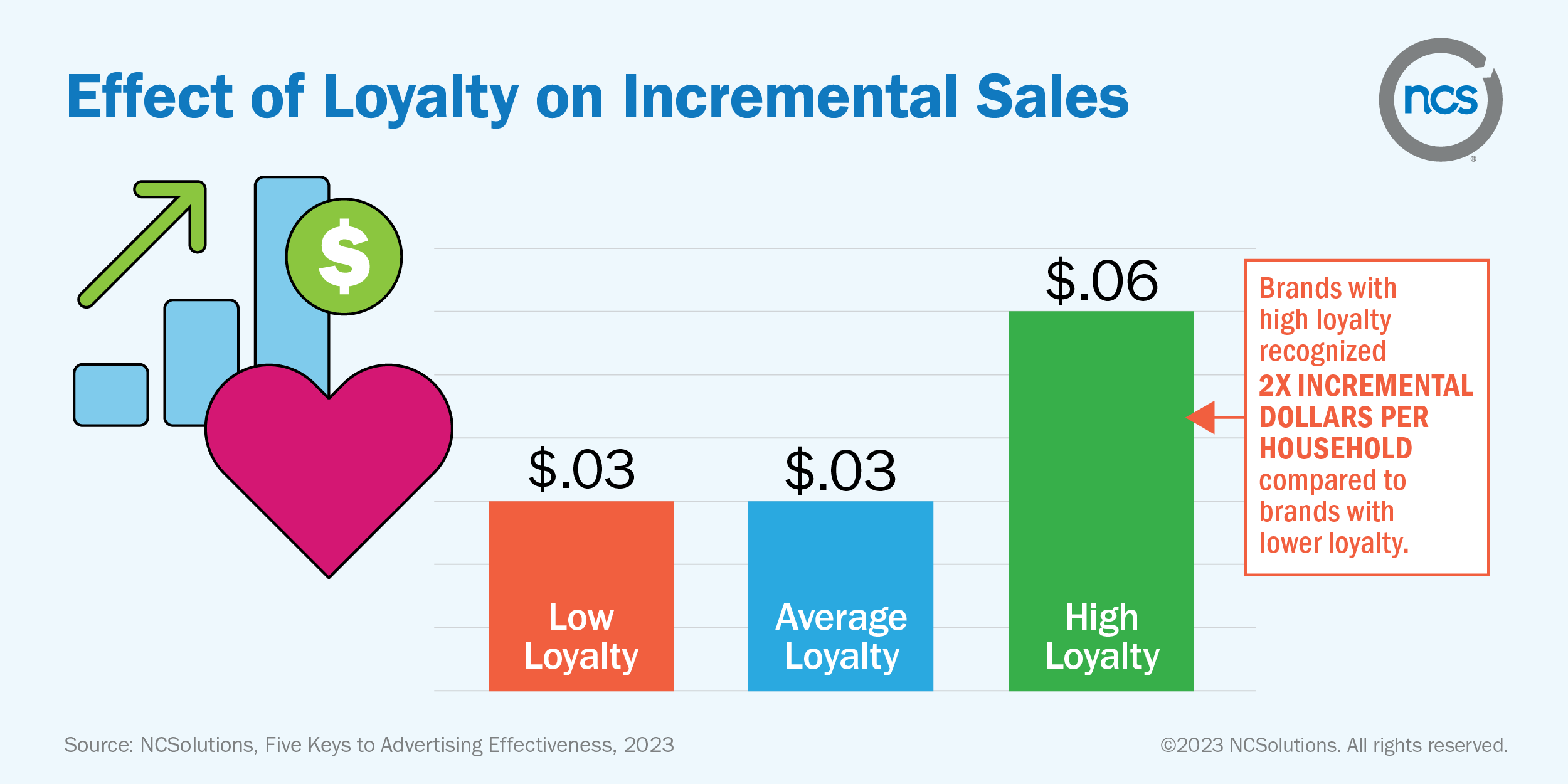In Advertising, the Balance Is Shifting: Brand Factors, Like Consumer Loyalty, Now Have a Greater Impact on Sales Results Than Reaching a Broader Audience
Update to Groundbreaking 2017 Study Reveals Evolution of the Five Keys to Advertising Effectiveness: Creative, Brand, Targeting, Reach, Recency
NEW YORK, August 10, 2023 – Brand factors, including consumer loyalty, market share and brand penetration, show the most significant change in a newly released study, updated from 2017, on the Five Keys to Advertising Effectiveness. NCSolutions found this element is responsible for 21% of incremental sales — an increase of 6% since its original study.
The five key elements that drive incremental sales are advertising creative, brand, targeting, reach and recency. When looking at the influence of audience reach, it now contributes 14% — down 8% since 2017. The data indicates how the balance is shifting in the advertising ecosystem.
The findings are the result of an update to NCSolutions’ (NCS) 2017 groundbreaking study, “The Five Keys to Advertising Effectiveness.” The update specifically looked at the primary drivers of incremental sales for advertising and select media comparisons. NCS is a leading company for improving advertising effectiveness for the consumer packaged goods (CPG) ecosystem.

In this meta-study analysis, advertising creative drives nearly half (49%) of incremental sales and remains the most critical driver of advertising effectiveness by a wide margin. Its impact is unchanged from 2017. Likewise, the effect of recency remained the same at 5%. Targeting influences 11% of incremental sales in 2023, a slight increase over 9% in 2017.
The five key elements for advertising effectiveness that drive incremental sales are:
- Creative: the advertising content that influences purchases through effective use of entertainment and experience.
- Brand: the combination of several long-term factors, including market share, brand penetration and the ability to retain loyal customers relative to the competition.
- Targeting: the measure of how well a campaign was able to reach an intended audience.
- Reach: the number of households reached by a campaign.
- Recency: when a consumer sees an ad in relation to their actual purchase.
“Short and long-term disruptions, like the pandemic, social media, e-commerce, delivery apps and the Gen Z buying block, are all major forces shaping how modern shoppers perceive brands and make purchase decisions,” said Alan Miles, CEO, NCSolutions. “These new findings about the five keys to advertising effectiveness make clear that brand factors play an increasingly influential role. Brands that put loyalty at the center of their marketing strategies often see a compounding effect on their bottom line.”
To help quantify the value of sales effect of brand loyalty, the study looked at the depth-of-repeat among brand buyers. This advertising metric measures the number of consecutive times a household bought a brand when purchasing in a particular category.
The study found that brands with the highest levels of consumer loyalty had twice the incremental sales as brands with average or low loyalty levels.

“Brand loyalty isn’t built overnight. It’s earned over a long period of time,” said Miles. “For instance, now is a good time for marketers to start to create connections with the newest generation of shoppers: Gen Z. But to do so, they need to be attuned to this generation’s preferences. They are twice as likely as baby boomers to be loyal to brands that prioritize the environment, so brands that align with this value can use it to build stronger relationships with these buyers.”
Earlier in the year, NCS and the CMO Council conducted a survey to understand where brand marketers can improve their capabilities and what challenges they need to overcome. Sixty-four percent of brand marketers use incremental sales to measure campaign performance, according to survey findings released in January by NCS and the CMO Council. Marketers can leverage the findings from the updated Five Keys to Advertising Effectiveness study to improve advertising outcomes across all media.
ABOUT THE FIVE KEYS TO ADVERTISING EFFECTIVENESS STUDY
In a meta-study of nearly 450 CPG campaigns across digital and TV formats, NCSolutions examined 18 features representing the five keys of advertising effectiveness (creative, brand, targeting, reach and recency). Using machine learning methodology, NCS modeled the proportional contribution of the five keys to short-term sales lift. NCS presented the results of the study at the ARF April AUDIENCExSCIENCE Conference.
Visit our how advertising works website to download a copy of the e-book with the full research.
ABOUT NCS
NCSolutions (NCS) makes advertising work better. Our unrivaled data resources powered by leading providers combine with scientific rigor and leading-edge technology to empower the CPG ecosystem to create and deliver more effective advertising. With NCS’s proven approach, brands are achieving continuous optimization everywhere ads appear through purchase-based audience targeting and sales measurement solutions that have impacted over $25 billion in media spend for our customers. Visit us at ncsolutions.com to learn more.
Fair Use
When using this data and research, please attribute by linking to this study and citing NCSolutions.
# # #


